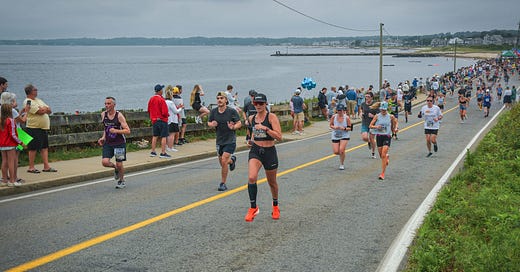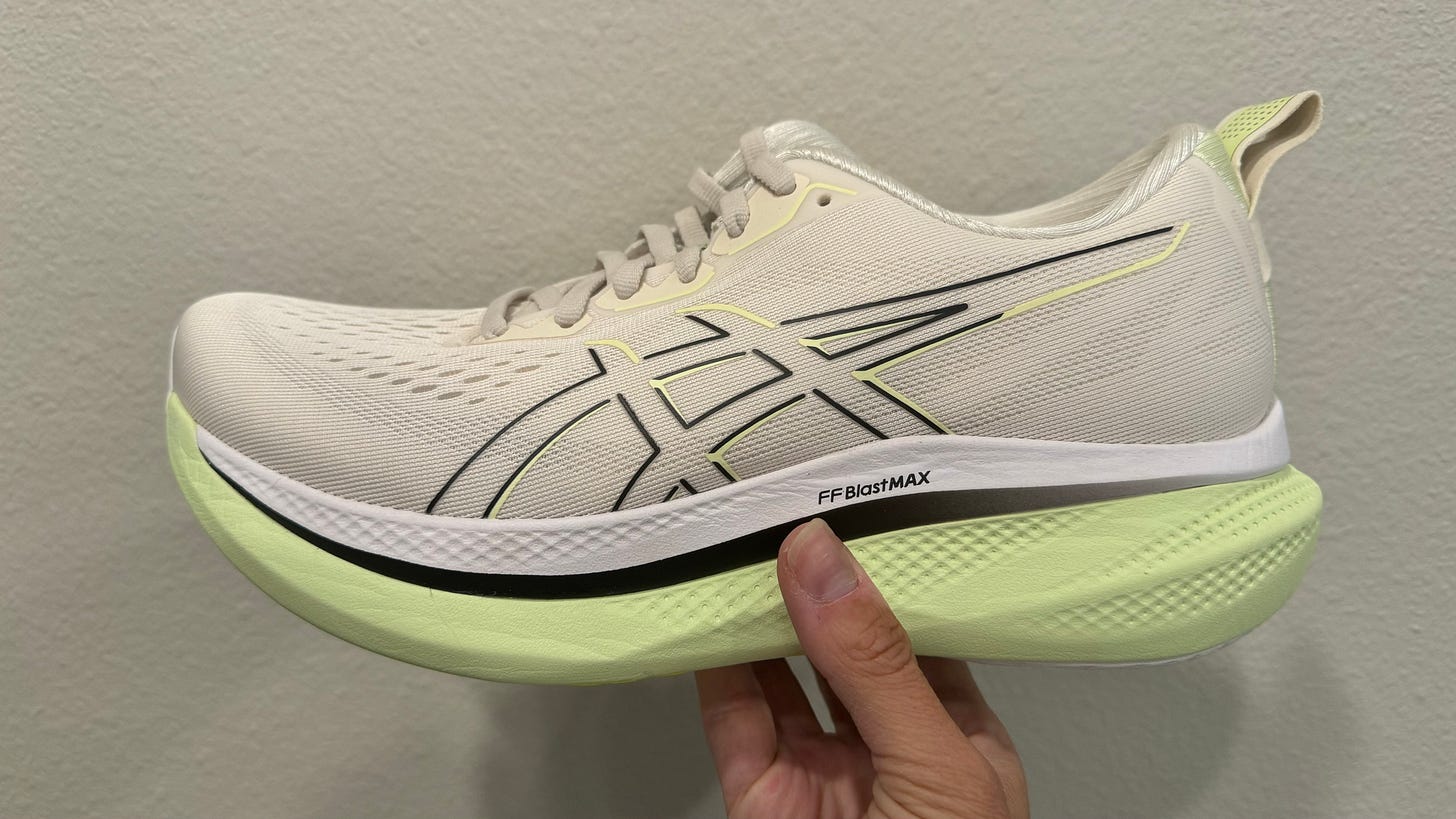Falmouth Road Race Recap
A great race setting, a not-so-great performance, but a 10/10 weekend all-around.
Every August, over 13,000 runners descend on the tiny village of Woods Hole to run seven miles across Cape Cod to Falmouth Heights. This event has been named one of the best races in the country, and regularly draws an international field of Olympians and elites—a far cry from the local 5K and 10Ks I used to watch in my New Jersey shore town.
The Falmouth Road Race essentially started as a bar-to-bar race: In 1973, the first runners ran from Captain Kidd restaurant to the old Brothers 4 club. Fifty years later, that community-centric vibe still remains, although runners come from all over the country to partake. It sort of reminds me of Bolder Boulder, with less mountains and more ocean views but the same kind of uplifting, vibe that makes even a rough day feel fun.
The seaside course starts at the harbor, passes the Nobska Lighthouse—a quintessential Cape sight—in the first mile, then winds over rolling hills for another two-ish miles before dumping you out alongside the Atlantic Ocean for a flat, exposed section before you turn back inland and weave around Falmouth Harbor to the final climb before a downhill finish. (If anyone tells you this race is flat, don’t believe them; the cumulative inclines in the first few miles can be rough, even though that total gain isn’t that crazy.)
This is my third time running Falmouth with the ASICS team, and it’s the kind of race I’d happily run every year. I really love a random race distance; seven miles is close enough to the 10K that you can aim for that pace, but you better be ready to fight for it at the end. (I think my favorite odd distance is 10 miles, though.)
The Falmouth Road Race generally takes place the third week of August, and it’s known for a high number of exertional heat stroke cases (the same medical director that oversees Falmouth is also in charge of the Boston Marathon medical services). Both years that I ran it—2021 and 2022—were exceptionally hot, compounded by that brutal east coast humidity and total sun exposure throughout the second half of the course. Honestly, this is probable where my interest in hot races, and how race directors plan to handle increasing temperatures, started.
This year was an exception. My Strava app recorded a temperature of 70°F, with a little bit of wind coming off the water. Sounds nice, right? Well, the humidity was 87 percent, which this Colorado runner was not quite prepared for. (Which is worse: altitude or humidity? I definitely think it’s the latter.) Those first few miles, which mostly take place off the shoreline, were so humid it was basically misting out, and I could tell my body was overheating right from the start. I also started right behind the elite men, so I went out way too hot. Rookie mistake or misguided optimism, who knows?
I came into Falmouth hoping to run around 10K pace. It felt like a good opportunity to get a harder effort in during marathon training, and after dealing with a cramp at the Slacker Half Marathon, I wanted to see if any of the measures I’ve undertaken since—a gait assessment, physical therapy, chirporactor visits, targeted sports massage—would help me feel better when sustaining that faster pace.
No such luck. I could tell my back was tight even before I started, and by mile two, the tightness had migrated from my back to my side and had firmly settled into that familiar Charley horse sensation in my abs by the 5K point. Mile four was agonizing—the cramp prevents my diaphragm from expanding, so I’m unable to breathe properly—but I was able to pull myself together a bit (mentally and physically) to steadily pick the pace back up throughout the remaining three miles and I still eked out a tiny course PR.
This race was never really about the finish time, and as much as I enjoyed the vibes and the setting, I was definitely disappointed in how it went—mostly because I’m struggling to see an easy solution to whatever is going on with this cramping situation. I don’t really want to call it an injury, but it’s definitely something that goes beyond typical soreness or pain while running harder efforts and I’m even aware of it during slower runs, although it’s not really a problem then. It’s something that’s affecting my daily life, too. I can still feel the soreness up my entire right side, from my lower back to my neck. The worst part is how it’s affecting my confidence; I spent a good chunk of those seven miles on Sunday wondering whether I’d even be able to run a marathon come fall.
So, back to the drawing board in terms of problem solving! The race may not have gone the way I wanted, but every race is a learning experience and the rest of the weekend was full of interesting people, great conversation, and an overall love for running—so I can’t complain. This race weekend will always get a 10/10 from me.
the rundown
ASICS GlideRide
Before ASICS started consistently releasing bangers like the Novablast and Metaspeed, their shoes didn’t really work for me—until the GlideRide, which had a big slab of softer, more responsive foam and an exaggerated rocker design that really worked for my stride (I wore it for the LA Marathon in 2020). The brand just released the next evolution, the GlideRide Max, and I was able to test it out during my shakeouts in Falmouth. It’s designed to be a long run cruiser, with FF Blast—ASICS’ most responsive foam—and a 3/4-length plate of hardpressed EVA that’s not quite as aggressive as what you’d find in the Metaspeed. Honestly, it’s most similar to the Nimbus, but it’s about 12 ounces lighter and I found it to have a little more pop underfoot.
Should Olympians Be Paid?
This summer, track and field was the first Olympic sport to award gold medalists prize money—an extra $50,000—World Athletics announced before the Games. The fact that that’s…not the norm is crazy to me, especially given how expensive it is to be an elite athlete. This brief article from The Spectator (it’s behind a paywall, but you can access it via a free trial) delves into the discrepencies between how the officials, organizers, and broadcasters are compensated for their roles compared to the competitors. Interestingly, I was just sent a study (including more than 1,800 athletes) that found that 59 percent of working athletes are female—so even though the Paris Olympics were the first in history to have an equal number of male and female athletes, there’s clearly still a gender gap at play.
Female Runners Have a Smaller Response to Super Shoes Than Male Runners
At this point, it’s pretty common knowledge that super shoes affect everyone differently. Gender does play a role in that, according to a July 2024 study published in Medicine & Science in Sports & Exercise. The study authors observed that "metabolic power improved by 4.2 percent in ‘super-shoes’ (but only by ~3.2% if controlling for shoe mass) in this cohort of competitive female runners, which is a smaller improvement than previously observed in men." Female runners tend to be smaller and lighter, which can make it more difficult to compress a shoe’s foam enough to get all the benefits. Something to consider when choosing a race day shoe!









Falmouth is such a fun race
Now that's an interesting problem. "Charley Horse" style cramp in the diaphragm. Not a classic side stitch? Right side?